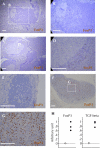CXC chemokine ligand 10 DNA vaccination plus Complete Freund's Adjuvant reverses hyperglycemia in non-obese diabetic mice
- PMID: 21409313
- PMCID: PMC3061611
- DOI: 10.1900/RDS.2010.7.209
CXC chemokine ligand 10 DNA vaccination plus Complete Freund's Adjuvant reverses hyperglycemia in non-obese diabetic mice
Abstract
Objective: Complete Freund's Adjuvant (CFA) is known to arrest autoimmune diabetes development in non-obese diabetic (NOD) mice. However, CFA alone cannot induce effective remission in diabetic NOD mice. Previously, we reported that anti-CXC chemokine ligand 10 (CXCL10) antibody can promote beta-cell proliferation in NOD mice. In the present study, we aimed to examine whether anti-CXCL10 plus CFA treatment can effectively reverse autoimmune diabetes development.
Methods: Systemic supply of anti-CXCL10 antibody by CXCL10 DNA vaccination in combination with CFA injection was performed in new-onset diabetic NOD mice. Remission rate of diabetes, histological characteristics of residual insulitis lesions, residual beta-cell mass, and regulatory T cell population in local pancreas were examined.
Results: A high frequency of diabetes reversal was observed after combination treatment with anti-CXCL10 plus CFA. In mice showing diabetes reversal, residual beta-cell mass was significantly increased, and some beta-cells were in a proliferative state. Although systemic cytokine profiles were unaffected, the frequency of "hybrid regulatory T cells", i.e. regulatory T cells expressing CXCR3, was significantly increased in local pancreatic lesions. This was possibly associated with the regulation of anti-islet autoimmunity.
Conclusions: Anti-CXCL10 plus appropriate immune adjuvant therapy arrested, and reversed, type 1 diabetes development.
Figures










References
-
- Atkinson MA, Eisenbarth GS. Type 1 diabetes: new perspectives on disease pathogenesis, and treatment. Lancet. 2001;358:221–229. - PubMed
-
- Kikutani H, Makino S. The murine autoimmune diabetes model: NOD, and related strains. Adv Immunol. 1992;51:285–322. - PubMed
-
- Delovitch TL, Singh B. The nonobese diabetic mouse as a model of autoimmune diabetes: immune dysregulation gets the NOD. Immunity. 1997;7:727–738. - PubMed
-
- Shimada A, Morimoto J, Kodama K, Suzuki R, Oikawa Y, Funae O, Kasuga A, Saruta T, Narumi S. Elevated serum IP-10 levels observed in type 1 diabetes. Diabetes Care. 2001;24(3):510–515. - PubMed
Publication types
MeSH terms
Substances
LinkOut - more resources
Full Text Sources
Other Literature Sources
Medical
